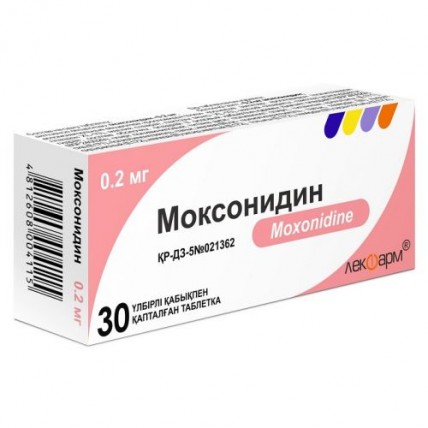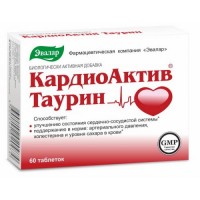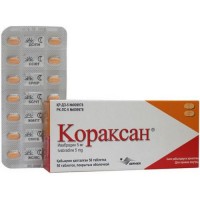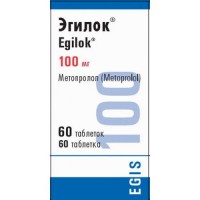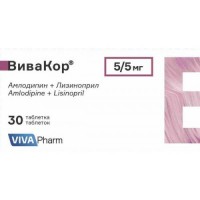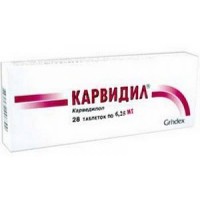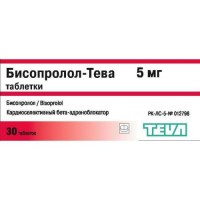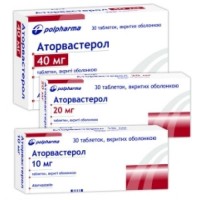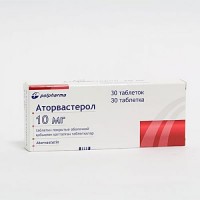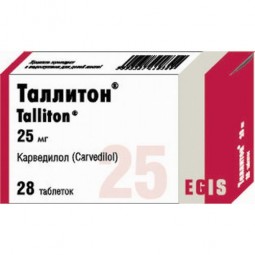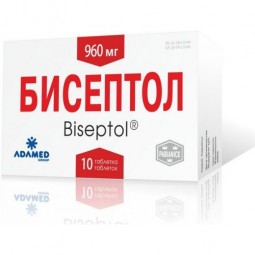Moxonidine 0.2 mg, 30 tablets
- $20.00
The instruction for medical use of MOKSONIDIN medicine the Trade name Moksonidin Mezhdunarodnoye the unlicensed name Moksonidin Lekarstvennaya the Tablet form, film coated, 0.2 mg and 0.4 mg One tablet contains Structure: active agent - moksonidin 0.2 mg or 0.4 mg, excipients: krospovidon (poliplazdon XL-10), magnesium stearate, lactoses monohydrate, for a dosage of 0.2 mg structure of a cover opadray II pink (85F240029): polyvinyl alcohol, the titan dioxide (E171), polyethyleneglycol, talc, gland (III) oxide red (E172), gland (III) oxide yellow (E172), for a dosage of 0.4 mg structure of a cover opadray II red (85F35222): polyvinyl alcohol, titan dioxide (E171), polyethyleneglycol, talc, gland (III) oxide red (E172), gland (III) oxide yellow (E172), gland (III) oxide black (E172). The description Round biconvex tablets, film coated light pink color (for a dosage of 0.2 mg). Round biconvex tablets, film coated henna-red color (for a dosage of 0.4 mg). Pharmacotherapeutic group Hypotensive drugs. 2-adrenomimetika alpha central, derivative imidazoline. Moksonidin. The ATX C02AC05 code the Pharmacological Pharmacokinetics Absorption Later properties of intake moksonidin quickly and almost is completely absorbed in upper parts of digestive tract. The absolute bioavailability is about 88%. Time of achievement of the maximum concentration - about 1 hour. Meal does not influence drug pharmacokinetics. Distribution Communication with proteins of blood plasma makes 7.2%. Metabolism the Main metabolite - dehydrogenated moksonidin. Pharmakodinamichesky activity of the dehydrogenated moksonidin - about 10% in comparison with moksonidiny. Removal Elimination half-life (T1/2) of a moksonidin and its metabolite makes 2.5 and 5 hours respectively. Within 24 hours over 90% of a moksonidin are removed by kidneys (about 78% in not changed look and 13% in the form of a degidromoksonidin, other metabolites in urine do not exceed 8% of the accepted dose). Less than 1% of a dose are removed through intestines. The pharmacokinetics at patients with arterial hypertension In comparison with healthy volunteers at patients with arterial hypertension is not noted changes of pharmacokinetics of a moksonidin. Pharmacokinetics at advanced age clinically insignificant changes of pharmacokinetic indicators of a moksonidin at elderly patients which are possibly caused by decrease in intensity of his metabolism and/or a little higher bioavailability Are noted. The pharmacokinetics at Moksonidin's children is not recommended for use at persons under 18 as in this group the pharmacokinetic researches were not conducted. The pharmacokinetics in a renal failure Removal of a moksonidin substantially correlates with the clearance of creatinine (CC). At patients with a moderate renal failure (KK in the range of 30-60 ml/min.) equilibrium concentration in blood plasma and final T1/2 approximately in 2 and 1.5 times is higher, than at persons with normal function of kidneys (KK more than 90 ml/min.). At patients with a heavy renal failure (KK less than 30 ml/min.), equilibrium concentration in blood plasma and final T1/2 is 3 times higher, than at patients with normal function of kidneys. Purpose of repeated doses of a moksonidin leads to predictable cumulation in an organism of patients with a moderate and heavy renal failure. At the patients with a terminal renal failure (KK less than 10 ml/min.) who are on a hemodialysis, equilibrium concentration in blood plasma and final T1/2 respectively in 6 and 4 times is higher, than at patients with normal function of kidneys. In all groups the maximum concentration of a moksonidin in blood plasma is 1.5-2 times higher. At patients with renal failures the dosage has to be selected individually. Moksonidin in insignificant degree is brought when carrying out a hemodialysis. Moksonidin's pharmacodynamics is antihypertensive with the central mechanism of action. moksonidin selectively stimulates imidazoline in stem structures of a brain - the sensitive receptors which are taking part in tonic and reflex regulation of sympathetic nervous system. Stimulation of imidazolinovy receptors reduces peripheral sympathetic activity and the arterial blood pressure (ABP). Moksonidin differs from other sympatholytic antihypertensives in lower affinity to α-adrenoceptors that explains a smaller likelihood of development of sedation and dryness in a mouth. Reception of a moksonidin leads to decrease in system vascular resistance and the ABP. The hypotensive effect of a moksonidin is confirmed in double blind people, placebo - controlled, randomized studies. The maximum of hypotensive effect is reached approximately in 2.5 – 7 h after the prima inside. Indications - arterial hypertension Inside, irrespective of meal, washing down the Route of administration and doses with enough liquid. In most cases the initial dose of a moksonidin makes 0.2 mg a day in one step, more preferably in the morning. At insufficiency of therapeutic effect the dose can be increased after 3 weeks of therapy up to 0.4 mg a day for 2 receptions or once. The maximum single dose makes 0.4 mg. The maximum daily dose which should be divided into 2 receptions makes 0.,6 mg. The sharp termination of reception of a moksonidin is not recommended. Reception of a moksonidin should be stopped gradually within 2 weeks. At patients with a moderate renal failure (SKF more than 30 ml/min., but less than 60 ml/min.) the single dose of a moksonidin of 0.2 mg and a daily dose of a moksonidin of 0.4 mg should not be exceeded. At the patients who are on a hemodialysis, the initial dose makes 0.2 mg a day. In case of need and at good tolerance the dose can be increased up to 0.4 mg a day. Researches on use of a moksonidin for patients with a liver failure were not conducted. Elderly patients with normal function of kidneys have recommendations on dozi-to a rovka same as well as for adult patients. Side effects determined the frequency of undesirable reactions Provided below, using the following scale: very often (& gt, 1/10), it is frequent (& gt, 1/100 - & lt, 1/10), infrequently (& gt, 1/1000 - & lt, 1/100), it is unknown (it is impossible to define on the basis of the available data). Especially at the beginning of therapy the most frequent side reactions were: dryness in a mouth, dizziness, a headache, an asthenia and drowsiness. The intensity and frequency of side effects decreases at repeated reception. From the central nervous system: often – a headache, dizziness, drowsiness, absent-mindedness, consciousness oppression, infrequently – a syncope. From a cardiovascular system: often – a vazodilatation, infrequently – bradycardia, sometimes – excessive decrease in the ABP, orthostatic hypotension, paresthesias of extremities, disturbances of peripheral circulation, Reynaud's syndrome. From an organ of hearing and balance: infrequently – sonitus. From digestive tract: very often – dryness in a mouth, it is frequent – diarrhea, vomiting, dispepsichesky disorders. From integuments and hypodermic fatty tissue: often – skin rash, an itching, infrequently – a Quincke's disease. From a musculoskeletal system and connective tissue: often – a dorsodynia, infrequently – neck pain. Mental disturbances: often – sleep disorders, difficulties of concentration of attention, infrequently – irritability. Disorders of vision: sometimes – dryness of an eye, burning sensation of an eye. Endocrine disturbances: sometimes – a gynecomastia, impotence and decrease in a libido. The general: sometimes – hypostases of various localization, weakness in legs, anorexia, pain in parotid glands. Contraindications - hypersensitivity to drug components - a sick sinus syndrome, sinuatrial and atrioventricular block of II and III degree, the profound bradycardia (the heart rate (HR) of rest less than 50 ud./ mines), chronic heart failure of III and IV class (on classification of NYHA) - unstable stenocardia - a Quincke's disease in the anamnesis - a heavy liver failure - chronic kidney disease (clearance of creatinine less 30ml/mines, creatinine more than 160 µmol/l) - children's and teenage age up to 18 years - pregnancy and the period of a lactation - a concomitant use with tricyclic antidepressants - hereditary intolerance of a galactose, deficiency of lactase or malyab-sorption of glucose galactose With care: Parkinson's disease (severe form), epilepsy, glaucoma, a depression, the "alternating" lameness, a Raynaud's disease, atrioventricular block of the I degree, chronic kidney disease (clearance of creatinine more than 30, but less than 60), cerebrovascular diseases, after the postponed myocardial infarction, chronic heart failure I and II class (on classification of NYHA), the patient who is on a hemodialysis because of a lack of experience of use – a moderate liver failure (more than 9 points on classification of Chayld-Pyyu). Medicinal interactions the Concomitant use of other antihypertensive drugs enhances hypotensive effect of a moksonidin. As tricyclic antidepressants can reduce effect of antihypertensive drugs of the central action, joint intake of tricyclic antidepressants with moksonidiny is not recommended. Moksonidin can enhance effect of tricyclic antidepressants (co-administration should be avoided), tranquilizers, alcohol, sedative and sleeping medicines. Moksonidin is capable to improve moderately weakened cognitive functions at the patients receiving lorazepam. Purpose of a moksonidin together with benzodiazepines can be followed by strengthening of sedation of the last. Moksonidin is brought by canalicular secretion. Interactions with other medicines, eliminiruyushchimisya by canalicular secretion cannot be excluded. At concomitant oral administration with glibenclamide the bioavailability of glibenclamide decreases by 11%. Special instructions C care are appointed Moksonidin at patients with possible predisposition to development of atrioventricular block and the patient with atrioventricular block of the 1st degree in order to avoid bradycardia. Patients with a serious ischemic disease or unstable stenocardia need careful observation as experience of use of Moksonidin for this group of patients is limited. It is recommended to observe precautionary measures at Moksonidin's appointment the patient with a renal failure as moksonidin it is removed by kidneys. These patients need careful selection of a dose, especially at the beginning of therapy. The initial dose of a moksonidin has to make 0.2 mg a day and, on condition of clinical indications and good tolerance, can be increased at most up to 0.4 mg a day at patients with a moderate renal failure (SKF & gt, 30 ml/min., but & lt, 60 ml/min.) and at most up to 0.3 mg a day at patients with a heavy renal failure (SKF & lt, 30 ml/min.). If Moksonidin accept in a combination with drug from group of beta blockers, then in need of cancellation of both drugs at first cancel beta blocker and only in several days - Moksonidin. The withdrawal at the termination of reception of Moksonidin is not observed. However it is not necessary to interrupt treatment sharply: it is recommended gradually, to reduce a dose within two weeks. Patients with inborn intolerance of a galactose, deficiency of Lappa lactase or disturbance of absorption of glucose galactose should not accept Moksonidin. Features of influence of medicine on ability to run vehicles or potentially dangerous mechanisms. During treatment it is necessary to abstain from driving of motor transport and occupations potentially dangerous types of activity demanding the increased concentration of attention and speed of psychomotor reactions. Overdose Symptoms: a headache, sedation, drowsiness, excessively significant decrease in the ABP, dizziness, the general weakness, bradycardia, dryness in a mouth, vomiting, fatigue and a stomach ache. Also short-term increase in the ABP, tachycardia, a hyperglycemia are potentially possible. Treatment: specific antidote does not exist. In case of a lowering of arterial pressure the restoration of volume of the circulating blood due to input of the fluid and introduction of a dopamine is recommended. Bradycardia can be stopped by atropine. Antagonists of alpha adrenoceptors can reduce or eliminate paradoxical arterial hypertension at overdose moksonidiny. A form of release and packing On 10 tablets in blister strip packaging from a film polyvinylchloride in accordance with GOST 25250-88 and aluminum foil according to TU 1811-002-45094918-97. On the 3rd blister strip packagings together with the instruction for medical use in the state and Russian languages place in a pack from cardboard in accordance with GOST 7933-89 Storage conditions to Store in the dry place protected from light, at a temperature not above 25 °C. To store out of children's reach! Period of storage 2 years. Not to use after the expiration date specified on packing. Release from drugstores According to the prescription Producer SOOO "Lekfarm", Republic of Belarus, 223110, Logoysk, Minskaya St., 2a the Owner of the registration certificate of SOOO "Lekfarm", Republic of Belarus in Republic of Kazakhstan 050013, Republic of Kazakhstan, Almaty, Boulevard Bukhar Zhyrau, 33
to Develop the Address of the organization accepting claims from consumers on quality of a product in the territory of the Republic of Kazakhstan Representative office of ROMFARM COMPANY of S.R. L.
to Develop the Address of the organization accepting claims from consumers on quality of a product in the territory of the Republic of Kazakhstan Representative office of ROMFARM COMPANY of S.R. L.
